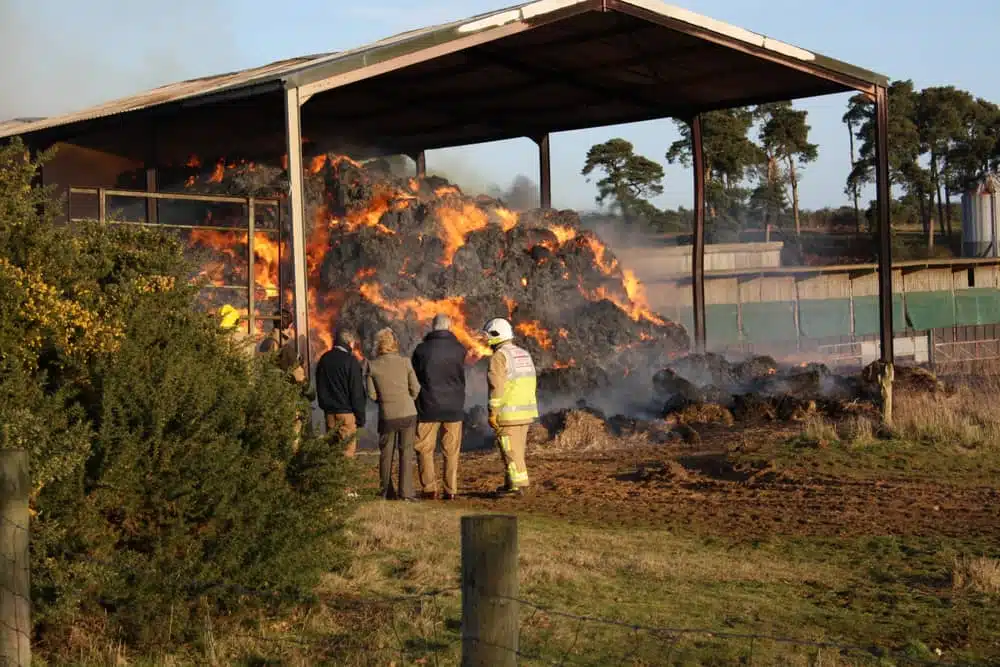Hay fires and prevention: A comprehensive guide
In every farmer’s life, there’s a story about hay bale catching fire—a topic shared over cups of tea with friends. Picture your hay, seemingly fine one day, then puffing steam, blowing smoke, and suddenly bursting into flames.
But why does this happen? More importantly, is it possible to prevent these situations that can take money away from hardworking farmers?
This guide explains the reasons behind hay bales catching fire and provides practical steps to protect your hay.

How do hay bales spontaneous combust?
Hay fires occur due to the spontaneous combustion of hay. This spontaneous combustion is triggered by excessive fermentation within the hay, primarily driven by bacteria and the hay’s moisture content. Fresh hay, rich in nutrients, is beneficial for your cows, but it’s also highly attractive to microorganisms.
When there’s moisture in the hay, it becomes a breeding ground for mesophilic bacteria. These little guys kick off a heat party, by breathing and reproducing, Just like us, they eat the sugars and proteins and produce heat and gas.
In hay, temperatures begin to rise between 130°F and 140°F (55°C-60°C), reaching up to 175°F (80°C) in extreme cases. Elevated temperatures, coupled with the accumulation of heat and gas in the presence of oxygen, initiate a fire.
The development of microorganisms makes the hay “dusty” and moldy. Now, the question arises: Is it viable to provide this moldy feed to cattle?
The answer is big no, there is a risk of under feeding the cows and create nutrition issues: production drops, silent oestrus, gestation problems or prolonged health issues for animals, due to a weakened immunity system. This adds an additional burden on the farmers, both in terms of financial costs and farm productivity.
Quanturi HAYTECH System
Measures to prevent hay bale fires
Curing of hay
It’s always better to consider every small action to protect your hay. When you cut your crop, make sure to keep an eye on the stalk’s moisture before baling. After cutting, the plants in the hay bale are still breathing—they’re turning the sugars from photosynthesis into energy. This is called respiration.
It takes several days for the cut grass to stop breathing. For all that time, just like us, it will turn sugar into energy and heat through respiration. Usually, it will heat up but then go down on its own. This is why it’s important to cure your hay before storing it!
However, when the hay is baled and stored, our little guys (microorganisms) are waking up and start their own respiration and fermentation process. A second heating cycle begins, and if you’re not careful with the temperature monitoring of your bales, temperature goes up and will not settle down.
Remember, putting a heating bale next to a random bale or on top of it, you have a high probability that the heat will “wake up” the little guys in the other random bale and trigger a fermentation process. So, be careful on how you pile your bales in storage.
Stacking and ventilation of hay bales in storage
If the heat produced during microbial fermentation is not effectively dispersed, and the haystack hinders proper ventilation, the temperature within the stack can escalate significantly. Additionally, the fermentation process generates flammable gases. Picture this: a combination of heat, flammable gas, and hay, and all it takes is a minimal influx of oxygen to ignite a hay fire.
Proper baling (not too dense), monitoring temperature levels, and ensuring good ventilation during stacking are essential measures to minimize the risk of hay fires caused by spontaneous combustion.
Hay that is tightly packed in round or square bales is highly susceptible to this process, which can lead to hay fires in the presence of oxygen. These fires typically occur within the first six weeks of storage, making this period particularly critical.
Use hay fire prevention equipment
How HAYTECH System works?
The Quanturi HAYTECH system is a smart wireless temperature monitoring solution designed to enable farmers to continuously monitor their stacked hay bales 24/7. This system provides real-time temperature data, which is crucial for early detection of potential overheating or spontaneous combustion.
Equipped with advanced sensors and user-friendly interfaces, the HAYTECH system alerts farmers to any significant temperature changes via mobile notifications or web dashboards, allowing for prompt intervention to prevent hay fires. This comprehensive monitoring ensures the safety and quality of stored hay, ultimately protecting valuable resources and livestock.
In conclusion, preventing hay fires in agriculture requires a proactive approach and an understanding of the factors that contribute to the spontaneous combustion of hay. Farmers can take crucial steps to minimize the risk of hay fires by monitoring temperature regularly and ensuring proper ventilation during stacking.
Frequently asked questions
Yes, hay can self-ignite due to spontaneous combustion. This occurs when excess moisture and microbial activity generate excessive heat in baled hay.
Hay bales can spontaneously combust due to the build-up of mold, mildew, and bacteria, often triggered by excess moisture. With the HAYTECH system’s temperature monitoring probes, you can track your hay’s condition in real time 24/7, detect potential risks early, and take proactive measures to prevent fires.
Hay fires typically occur within six weeks of baling. Heating begins in hay with moisture content above 15%, usually peaking at temperatures between 125–130°F (51–54°C) within three to seven days. At this stage, the risk of combustion or loss of forage quality is minimal. However, if the heat continues to rise, the risk of fire and quality loss increases.
To avoid hay fires, it’s important to properly cure your hay before storage by monitoring moisture levels in the hay stalks. After cutting, hay continues to generate heat through respiration, which can increase the risk of fire if not managed. Once baled, microorganisms in the hay can cause a second heating cycle through fermentation. Without careful temperature monitoring, this heat can build up and become dangerous. To reduce the risk, always ensure your hay is properly cured, monitor temperatures regularly, and store bales carefully to prevent heat from transferring between them.

Marie Huyghe
Author
Agronomist Quanturi Oy

Hassan Ali
Reviewer
Performance Marketer Quanturi Oy
